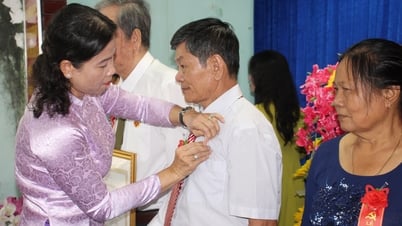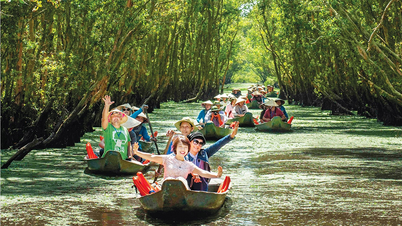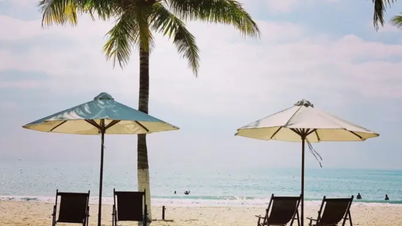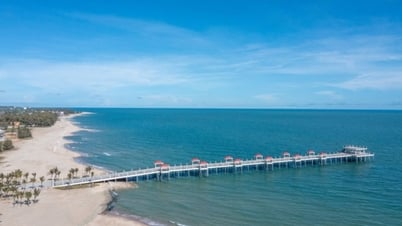Updated date: 04/18/2025 10:10:26

DTO - The Red-crowned Crane - a rare bird with special value in terms of biodiversity, was once closely associated with the wetland ecosystem of Tram Chim National Park, an ecological symbol of Dong Thap province. However, over the past many years, due to the impact of climate change and habitat loss, this bird species has gradually disappeared. With the determination to restore and conserve the Red-crowned Crane, Dong Thap province has proactively implemented the Project on Conservation and Development of Red-crowned Cranes in Tram Chim National Park for the period 2022 - 2032. In particular, bringing the Cranes from Thailand to Tram Chim marks a pioneering step, demonstrating a strong commitment to nature conservation and sustainable development orientation.

Dr. Tran Triet - Director of Southeast Asian Crane Conservation, International Crane Association spoke at the Program to announce the Project for Conservation and Development of Red-crowned Cranes in Tram Chim National Park for the period 2022 - 2032
As a companion to the Project, Dr. Tran Triet - Director of Southeast Asian Crane Conservation, International Crane Association, had an interview with Dong Thap Newspaper about the meaning, expectations and orientation of this special Project.
Reporter: From the perspective of an expert who has researched the Red-crowned Crane for many years, how do you evaluate the ecological role of Tram Chim National Park in the natural habitat network of this rare bird species in Southeast Asia?
Dr. Tran Triet: Tram Chim National Park used to have the most cranes in the entire lower Mekong River basin. Therefore, this is still a very important place for the Red-crowned Cranes of both Cambodia and Vietnam. Natural habitats like those of Tram Chim National Park are not much left in the area. In the past 3 years, the restoration of natural ecosystems in the core zone of Tram Chim National Park has been carried out, leading to many positive results, demonstrated by the restoration of grasslands and the increase in the number of many bird species. Some Red-crowned Cranes have also returned to explore. With this recovery momentum, if Dong Thap continues to do a good job of ecosystem management, I believe that the natural cranes will also return to Tram Chim in the near future.

Red-crowned cranes in Tram Chim National Park (Photo: Thanh Phong)
Reporter: What is the significance of Dong Thap bringing Red-crowned Cranes from Thailand to Tram Chim National Park to restore the population and breeding habitat in terms of species conservation, biodiversity and climate change response, sir?
Dr. Tran Triet: The Eastern Sarus Crane subspecies of Cambodia and Vietnam currently has a very small population (less than 200 individuals), is declining at a very rapid rate, and is at risk of extinction. The project to restore the crane flock in Tram Chim National Park has a direct impact on introducing more cranes into the wild, and at the same time hopes to create a flock of cranes that can live permanently in Vietnam all year round. This will contribute to reducing the risk of extinction of this subspecies.

The ecosystem and green grass area inside the Red-crowned Crane cage are recreated to resemble the natural conditions outside.
Other impacts of the Project include the restoration of natural ecosystems in the core zone of Tram Chim National Park and the establishment of ecological rice production areas, and emission reduction in the buffer zone, which will make important contributions to the conservation of ecosystems, biodiversity, and response to climate change.
Reporter: From the perspective of sustainable development, how do you assess the potential for combining Red-crowned Crane conservation with socio-economic development in Dong Thap, especially in the fields of environmental education, ecotourism and local branding?
Dr. Tran Triet: The Red-crowned Crane Restoration Project has actually been providing great support for environmental education. Many promotional activities of Dong Thap province have spread messages about crane conservation, biodiversity conservation, and environmental protection nationwide. In addition to educational effects, these promotional programs also directly enhance the image and reputation, including popularizing local brands. Of course, ecotourism will be one of the economic sectors that benefit.
Reporter: In the process of implementing the Project, in your opinion, what are the advantages and difficulties that Dong Thap needs to identify in order to develop appropriate solutions?
Dr. Tran Triet: Currently, the Red-crowned Crane Restoration Project is receiving great public attention and support. Many organizations, businesses, and individuals have made direct contributions. The project has also received very good cooperation from Thai partners and international nature conservation organizations. The leaders of Dong Thap province are very interested and have given close and decisive direction. These are great advantages, contributing to the long-term success of the project.


Red-crowned crane in Buriram province, Thailand (taken on April 9, 2025 - Dr. Tran Triet)
One of the difficulties is that the international cooperation capacity of Tram Chim National Park is still limited and needs to be quickly supported to improve. The development of ecological rice areas in the buffer zone needs to be focused on and implemented to keep up with the progress of the crane development. In addition, we need to clearly understand that the restoration of the Sarus Crane is a long-term process and needs to be carried out continuously and without interruption. Thailand has implemented the program for more than 30 years and is still implementing it thoroughly every year. Our cooperation with Thailand has saved 20 years of learning and building your cranes. However, this is still a long-term process.
Reporter: As a professional advisor and companion, how will you support Dong Thap in building an effective, sustainable Red-crowned Crane conservation model that can spread at the regional and international levels?
Dr. Tran Triet: The International Crane Society and the University of Natural Sciences in Ho Chi Minh City, where I work, are committed to working with Dong Thap to implement the Sarus Crane Conservation Project. In addition to my expertise in the restoration and management of wetland ecosystems and crane habitats, I will also be responsible for acting as a “bridge” between Tram Chim National Park and Thai agencies and the International Crane Society as well as other nature conservation organizations to provide necessary professional advice and support.
Reporter: Thank you very much!
My Ly (performed)
Source: https://baodongthap.vn/moi-truong/hoi-sinh-seu-dau-do-o-tram-chim-buoc-di-tien-phong-trong-bao-ton-da-dang-sinh-hoc-130803.aspx






![[Photo] Prime Minister Pham Minh Chinh chairs conference on anti-smuggling, trade fraud, and counterfeit goods](https://vphoto.vietnam.vn/thumb/1200x675/vietnam/resource/IMAGE/2025/5/14/6cd67667e99e4248b7d4f587fd21e37c)






















































































Comment (0)